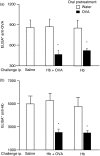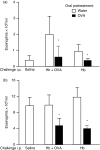Cell-mediated immune response to unrelated proteins and unspecific inflammation blocked by orally tolerated proteins
- PMID: 18759750
- PMCID: PMC2669816
- DOI: 10.1111/j.1365-2567.2008.02901.x
Cell-mediated immune response to unrelated proteins and unspecific inflammation blocked by orally tolerated proteins
Abstract
Oral tolerance promotes a generalized decrease in specific immune responsiveness to proteins previously encountered via the oral route. In addition, parenteral immunization with a tolerated protein also triggers a significant reduction in the primary responsiveness to a second unrelated antigen. This is generally explained by 'innocent bystander suppression', suggesting that the transient and episodic effects of inhibitory cytokines released by contact with the tolerated antigen would block responses to the second antigen. In disagreement with this view, we have previously shown that: (i) these inhibitory effects do not require concomitance or contiguity of the injections of the two proteins; (ii) that intravenous or intragastric exposures to the tolerated antigen are not inhibitory; and (iii) that the inhibitory effect, once triggered, persists in the absence of further contact with the tolerated protein, possibly by inhibition of secondary responsiveness (immunological memory). The present work confirms that immunological memory of the second unrelated antigen is hindered by exposure to the tolerated antigen and, in addition, shows that this exposure: (i) inhibits the inflammation triggered by an unrelated antigen through the double effect of inhibiting production of leucocytes in the bone marrow and blocking their migration to inflammed sites; and (ii) significantly blocks footpaw swelling triggered by carrageenan. Taken together, these results conclusively demonstrate that inhibitory effects of parenteral injection of tolerated antigens are much more general than suggested by the 'innocent bystander suppression' hypothesis.
Figures







Similar articles
-
Indirect effects of oral tolerance cannot be ascribed to bystander suppression.Scand J Immunol. 1997 Mar;45(3):276-81. doi: 10.1046/j.1365-3083.1997.d01-394.x. Scand J Immunol. 1997. PMID: 9122617
-
Indirect effects of immunological tolerance to a regular dietary protein reduce cutaneous scar formation.Immunology. 2017 Jul;151(3):314-323. doi: 10.1111/imm.12732. Epub 2017 Apr 6. Immunology. 2017. PMID: 28295241 Free PMC article.
-
Indirect effects of oral tolerance in mice.Scand J Immunol. 1994 Jun;39(6):533-8. doi: 10.1111/j.1365-3083.1994.tb03410.x. Scand J Immunol. 1994. PMID: 8009172
-
Oral tolerance to protein antigens.Allergy. 2001;56 Suppl 67:12-5. doi: 10.1111/j.1398-9995.2001.00904.x. Allergy. 2001. PMID: 11297999 Review.
-
Immunity induced after a feed of antigen during early life: oral tolerance v. sensitisation.Proc Nutr Soc. 2001 Nov;60(4):437-42. doi: 10.1079/pns2001119. Proc Nutr Soc. 2001. PMID: 12069395 Review.
Cited by
-
Participation of Leukotrienes in the Immune Modulation of Oral Tolerance.Front Microbiol. 2017 Feb 21;8:242. doi: 10.3389/fmicb.2017.00242. eCollection 2017. Front Microbiol. 2017. PMID: 28270799 Free PMC article.
-
Systemic effects of oral tolerance improve the healing of several and concomitant wounds on different parts of the body.Braz J Med Biol Res. 2025 Apr 14;58:e14689. doi: 10.1590/1414-431X2025e14689. eCollection 2025. Braz J Med Biol Res. 2025. PMID: 40243821 Free PMC article.
-
Systemic effects of oral tolerance in bone healing.Sci Rep. 2023 Apr 18;13(1):6296. doi: 10.1038/s41598-023-33591-4. Sci Rep. 2023. PMID: 37072616 Free PMC article.
-
Prolonged antigen ingestion by sensitized mice ameliorates airway inflammation.ISRN Allergy. 2011 Dec 1;2011:818239. doi: 10.5402/2011/818239. Print 2011. ISRN Allergy. 2011. PMID: 23724232 Free PMC article.
-
Subcutaneous injection of an immunologically tolerated protein up to 5 days before skin injuries improves wound healing.Braz J Med Biol Res. 2022 Feb 9;55:e11735. doi: 10.1590/1414-431X2021e11735. eCollection 2022. Braz J Med Biol Res. 2022. PMID: 35170683 Free PMC article.
References
-
- Hanson DG, Vaz NM, Maia LC, Hornbrook MM, Lynch JM, Roy CA. Inhibition of specific immune responses by feeding protein antigens. Int Arch Allergy Appl Immunol. 1977;55:526–32. - PubMed
-
- Richman LK, Chiler JM, Brown WR, Hanson DG, Vaz NM. Enterically-induced immunological tolerance – I. Indution of supressor T limphocytes by intragastric administration of soluble protein antigens. J Immunol. 1978;121:2429–34. - PubMed
-
- Gautam SC, Battisto JR. Suppression of contact sensitivity and cell-mediated lympholysis by oral administration of hapten is caused by different mechanisms. Cell Immunol. 1983;78:295–304. - PubMed
Publication types
MeSH terms
Substances
LinkOut - more resources
Full Text Sources
Other Literature Sources

